2017 Suzuki GSX-R1000R Review - First Ride
Team S leans on MotoGP technology to shoot for the superbike pinnacle
Ah, the legendary Phillip Island circuit, the scene of many epic battles among two-wheel gladiators like Gardner, Rainey, Schwantz, Corser, Stoner, Rossi and Iannone, which has long been on my bucket list of racetracks to ride before I die. With significant elevation changes along 2.76 miles of twisting tarmac on the shores of the Indian Ocean and an average GP speed of more than 110 mph, it would be a challenge to learn on any bike, let alone on Suzuki’s most powerful literbike ever.
2017 Suzuki GSX-R1000R
| Engine | 19.0/20 |
| Suspension/Handling | 14.0/15 |
| Transmission/Clutch | 9.5/10 |
| Brakes | 9.0/10 |
| Instruments/Controls | 4.5/5 |
| Ergonomics/Comfort | 8.0/10 |
| Appearance/Quality | 8.0/10 |
| Desirability | 8.0/10 |
| Value | 8.0/10 |
| Overall Score | 88/100 |
Oh, and don’t forget to dodge the seagulls and geese strolling around trackside, nor the goose that flew in front of me while I railed through Hay Shed corner at a buck-10 and missed me by just inches!
The new Gixxer Thou – the sixth generation known internally as the L7 – has some big shoes to fill. A multi-time champion racebike since its 2001 introduction, it’s been the better part of a decade since it was last updated in 2009 (the K9). But based on my ride in Australia, Suzuki engineers have obviously been sweating the details to create what is surely the fastest and most capable GSX-R ever.
This test is of the GSX-R1000R, not the standard GSX-R1000 we’ll be riding in a couple of months. With an MSRP of $16,999, this Gixxer is now playing in the big leagues of superbikes, packed full of technology that previously had been mostly the purview of high-dollar European machines. Its 999.8cc powerplant shrieks to 14,500 rpm and catapults the Gixxer Thou to 180-plus-mph by the end of Phillip Island’s front straight.
Five Fun Facts About The 2017 Suzuki GSX-R1000
The standard GSX-R1000 is new from the ground up and includes a raft of high-tech features like ride-by-wire throttle, variable valve timing, a finger-follower valvetrain, Brembo monoblock brakes and a six-axis IMU (Intertial Measurement Unit). Its price starts at $14,599 and rises to $14,999 with ABS. To that the 1000R adds Showa Balance Free suspension, quickshifter with auto-blipping downshifts, cornering ABS and launch control.
A few clever tricks in the engine compartment bring hand-of-god power to the masses. Most interesting is an inventive variable-valve-timing system that has roots back to the late 1990s when the GSX-R’s project leader, Shinichi Sahara, developed it with his colleague and then implemented it during Suzuki’s original MotoGP program. Sahara-san was the MotoGP technical manager from 2004 to 2010, and this ingenious VVT system, patented by Suzuki, was later adapted in 2012 for use on World Superbike and World Endurance GSX-R1000 racing machines, and then recently to MotoAmerica superbikes.
It’s a remarkably simple mechanical system using an intake-cam-drive gear filled with a dozen steel balls that are spun outward at high revs by centrifugal force along slanted channels. The cam timing at lower engine speeds is in an advanced state for optimum grunt, but once past 10,000 rpm, the system retards cam timing to increase high-rpm power.
Another simple but clever solution is found in the mill’s intake. The Suzuki Dual-Stage Intake (S-DSI) system is said to offer the advantages of variable-length intake funnels without the added complexity and weight of a movable system. Suzuki’s dual-stage layout in two of the four intake funnels use a longer funnel positioned above a short funnel, with a gap between the two sections.
At lower engine speeds, most of the air flows through the upper funnel, using the longer length to increase low and midrange power. Then at higher revs, additional air flows around the base of the longer upper funnel and into the short lower funnel, increasing top-end thrust. Further aiding breathing is a set of of 2mm-bigger throttle bodies (to 46mm) incorporating one set of injectors in the body, and another set of injectors spraying at their upper ends, directed by the ECU controlling throttle butterflies via a ride-by-wire system.
Also new is the use of a finger-follower valvetrain as developed in F1 auto racing and popularized on motorcycles by BMW with its class-topping S10000RR. It’s a lighter system than a typical bucket-tappet arrangement (said to be 10 grams vs. 16 grams), and its moving mass is further reduced to a claimed 3 grams because each follower pivots on a fixed shaft rather than a bucket placed directly on top of the valve stem. Intake valve sizes go up by 1.5mm to 31.5mm, while exhaust valves transition from steel to titanium and shrink 1mm to 24mm, for a reduction of 8 grams each.
The lighter valvetrain and its precise control, combined with a more oversquare bore/stroke ratio and the abandonment of a balance shaft has allowed the engine’s rev limit to be raised 1000 revs to a lofty 14,500 rpm.
Engineers considered using a crossplane-style crankshaft arrangement popularized by Yamaha in its M1 and R1, and like Suzuki uses in its MotoGP bike, but that configuration forces a heavier engine block to contain the additional vibration and also saps some power relative to a traditional inline-Four crank layout. And with advancements in IMUs that supply excellent traction-control systems, any extra traction delivered from a crossplane layout becomes negligible.
All told, Suzuki claims 199 horsepower at 13,200 rpm when tested at its crankshaft, a number that should translate to about 180 horses at its rear wheel. Torque remains similar to the previous edition at 86 lb-ft at 10,800 rpm.
Somewhat disappointingly, Sahara-san told me that noise restrictions in the USA will somewhat clip peak horsepower output compared to the European tuning of the bikes we rode, just like it does with Yamaha’s R1 and Kawi’s ZX-10R in America. Sahara says USA bikes have the same power as Euro bikes up to 13,000 rpm, at which point the intake butterflies close slightly to reduce noise output.
Now, before the internet pundits chastise Suzuki (and America) for nipping maximum power, please consider how often you’re likely to be using full throttle above 13,000 rpm when riding on the street. This noise-abatement strategy is only really an issue if you’re a racer, and if you’re a racer, you’ll be retuning the engine anyway.
Interestingly, I was given a brief look at a dyno chart by one of Suzuki’s German test riders, Jurgen Plaschka, Assistant Manager, Test And Technique. His chart showed the old Gixxer spat out 178 PS (slightly higher than our hp), while the L7 GSX-R churned out 203 PS, one pferdestarke more than the nearly omnipotent S1000RR BMW did on the same dyno. More is more, of course, but the chart’s important distinction is the Gixxer’s significant surfeit of power over the BMW from 9,500 to 13,000 rpm, demonstrating the advantages of Suzuki’s VVT and other power-broadening technology.
Jeez, I just burned a short novel’s worth of words describing the engine before getting to any riding impressions, but I did so because it’s the Gixxer’s motor and the technology inside that is the most impressive part of this all-new bike. It pulls like a rocket powered by crystal meth, and its sonic profile at full song will raise the hairs on your neck as it wails to a previously unheard of 14-and-a-half-freaking-thousand rpm. I saw the speedometer on the nicely readable LCD instrumentation sail past 180 mph lap after lap during my sessions, and that was even without shifting up to sixth gear!
The motor’s not quite flawless, though. Throttle pickup in the S-DMS A mode can be slightly abrupt in slow corners, although it’s completely smoothed out in B mode. Credit Suzuki for allowing the same peak power in all three of its ride modes, making neither of the softer settings just throwaway gimmicks. I preferred the sharper A mode on the racetrack, but I’d lean toward B mode if I was on a switchback-y canyon road.
The other aspect of the engine that wasn’t entirely pleasurable was the vibration transferred to my hands. Remember, this is the first GSX-R1000 without a balance shaft – taking another cue from the S1000RR – so additional vibes are going to be part of the package. I could feel the buzz via the handlebars and most prominently through the edges of the fuel tank when tucked in and leaned over. Four journalists I polled said the vibes didn’t bother them, so this minor annoyance for me wasn’t a problem for some others. Still, it’s clearly felt relative to the former engine’s relatively smooth character.
Less noticeable is the the 1000R’s suspension, and I mean that in the best possible way. The fully adjustable Showa Balance Free suspension does a phenomenal job of controlling wheel movement while still remaining supple enough to suck up bumps while leaned over. Suzuki started us out on street settings, which were perfectly acceptable to me while I was getting up to speed on the fast and flowing Phillip Island circuit. Track settings were dialed in for our second session, which firmed up responses and kept the chassis composed while I knocked seconds off my lap times.
This latest Gixxer steers a bit quicker than the previous edition, although it’s difficult to pinpoint exactly why. One reason is that a 190/55 replaces the flatter, old-style 50 series rubber. The L7 GSX-R has moderately sharper steering geometry but a 15mm longer wheelbase, which might balance their effects. New wheels with six thin spokes replace three-spokers, but we weren’t given specs on their relative weights. The swingarm is 40mm longer but is offset by a shorter distance from the front axle to the swingarm pivot, which is said to improve front-end feedback. The frame itself is 10% lighter and 20mm narrower, and it looks far more diminutive than I’d think a literbike frame could be. Fueled up and ready to ride, Suzuki says the Gixxer scales in at 448 lbs – quite a bit more than the recently reviewed 2017 Honda CBR1000RR, which tipped the scales at 425 lbs.
Top-shelf components are also found in the brake system, with Brembo supplying one-piece calipers and 320mm rotors that combine traditional floating-pin button carriers with Brembo’s floating T-drive mounts. The brakes prove to have slightly less initial bite than some top-end Euro bikes, but it’s not a problem for me, as I don’t mind using more lever travel when grabbing a handful at 180 mph. Sheer power is plentiful.
The 1000R comes with the new Motion Track Brake System regulated by the IMU. It reduces rear-wheel lift during maximum braking, and it also factors in lean angle. As my speed increased, so did my braking force, and at one point I felt some minor pulsing at the front lever when hammering on the binders into Turn 1. It wasn’t really problematic, but I initially thought I might be experiencing the effects of a slightly warped brake rotor.
For the next session, Suzuki gave us the opportunity to ride the bike with the ABS system deactivated. Oddly, Suzuki technicians had to disengage ABS by pulling a fuse rather than using some sort of switch mechanism. Regardless, the pulsing – probably from the rear-lift mitigation – wasn’t felt again.
In terms of other electronic rider aids, the Continental IMU and its traction-control system proved to be excellent. I really appreciate the safety aspects to TC systems, but they’re annoying when they intervene too soon or too abruptly. Suzuki offers 10 settings, and they’re able to be adjusted on the fly by the mode button on the left switchgear if the throttle is closed; off is also an option. TC3 was close to optimal for my preferences, as it still allowed the rear tire to slide without unwanted intervention. As the stock Bridgestone RS10s got used up, more sliding ensued.
My only gripe with the system is that TC is also the method that controls wheelies. TC3 limits lifting the front tire to just a few inches, which is great for pinning the throttle and allowing the electronics to deliver maximum acceleration on a racetrack. TC2 allows larger wheelstands, and TC1 more again. But I’d prefer to be able to choose the wheelie ability independent of traction-control selection. When I brought this up to Sahara-san, he agreed with me that he’d prefer wheelie control separated from TC, leading me to believe we will see such an electronic upgrade in the future if the product-liability lawyers will allow it.
No gripes at all with the quickshifter’s performance. Upshifts are perfectly seamless, and the auto-blipping downshifter nicely matched revs during downshifts even when they weren’t ideally timed. The system worked so well that thoughts about it drifted away to nothingness. On a slightly related note, the assist/slip clutch has a light pull.
Ergonomically, the new GSX-R has an identical rider triangle to the older one, with bars, seat and footrests in the same positions we’ve enjoyed in years past. Bodywork and the fuel tank are slightly narrower, making the bike feel slimmer. Also narrower, by 13mm, is the front fairing, which allows a bit more wind to hit a rider. However, the fuel tank is 21mm lower, which lets a rider crawl into a modestly sheltered cocoon of still air.
Bridgestone R10 race rubber was fitted to our bikes after lunch, which dramatically upped the grip levels. Their sharper profiles aided steering quickness, and I noticed their stiffer carcass aided front-end feedback. I figured they might be worth a couple of seconds a lap over the RS10s, and Plaschka reckoned they might net even more time.
And the new GSX-R1000R is so capable that I was continuing to find new limits as I extracted new ways to go faster and faster. From what I was able to tell at Phillip Island, going quicker each time out, I see huge potential for this L7 GSX-R platform, both for racy street riders and for pure racers. It wouldn’t surprise me to see Toni Elias or Roger Hayden pull off a MotoAmerica Superbike championship in 2017. And maybe 2018.
Engineers are always proud of the motorcycles they create, but Suzuki’s team seemed particularly proud of their accomplishment with its latest GSX-R, especially considering the typical modesty displayed by Japanese. Yet at the end of the Gixxer’s presentation, Sahara-san quipped: “I would say to our competitors, ‘Who’s your daddy?’”
2017 Suzuki GSX-R1000R
+ Highs
- Remarkably strong powerband
- Stout electronics package
- Terrific suspension
– Sighs
- Lots of yen
- Vibey
- Stiff class competition
More by Kevin Duke




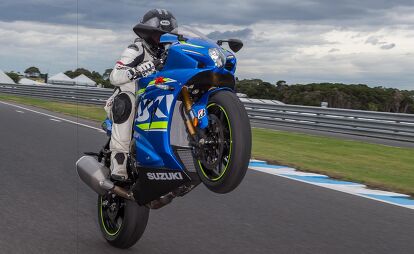































































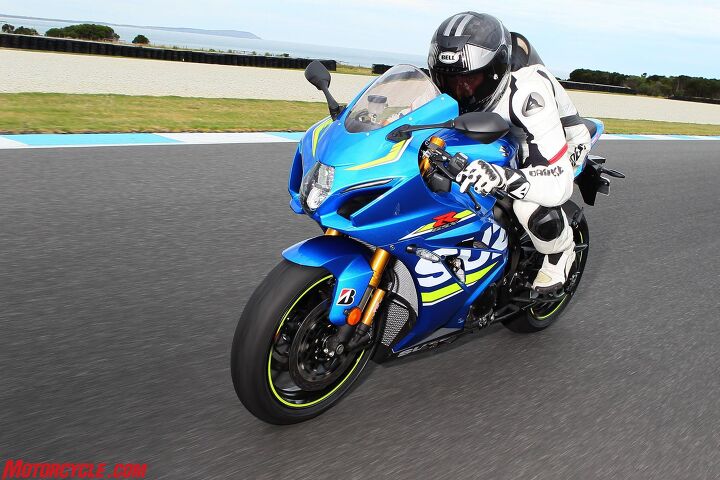


















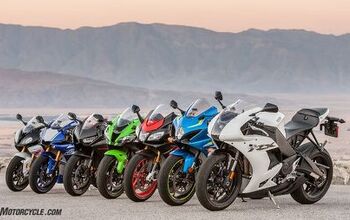

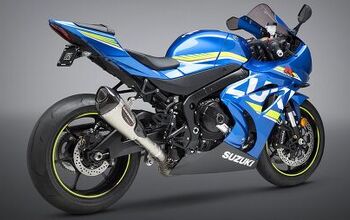
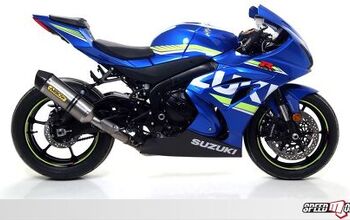












Comments
Join the conversation
"Now, before the internet pundits chastise Suzuki (and America) for nipping maximum power, please consider how often you’re likely to be using full throttle above 13,000 rpm when riding on the street."
Are you kidding me-- don't you know how many absolute riding GODS are on the internet LOL
Very nice review.
Ha ha, I can't believe I didn't notice the cooperation between Revvin' Kevin and Slow Kevin before. To get advice from the champ must've been awesome. You should work that into an article some day.